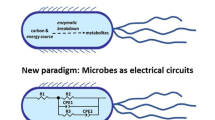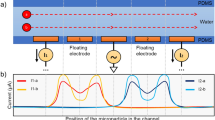Abstract.
We introduce a new laboratory-scale impedance-meter which is specially intended for indirect technique. It consists of a software system enabling data acquisition via a connected bus which is wired to the measuring cells. These measuring cells are individual impedance-meters that can be activated independently of one another. In the current configuration, the device is slightly affected by temperature, but it can register as little as 10.9 µmol of CO2. With Bacillus subtilis, Escherichia coli, and Saccharomyces cerevisiae cultures, the conductance responses were highly replicable and repeatable for inocula concentrations of 1–108 colony-forming units (CFU) ml−1. The main use for such devices could be the detection of contamination in foodstuffs. Several of these foodstuffs, when incubated at 37 °C, spontaneously release quite large amounts of CO2. Our impedancemeter, however, was able to detect an E. coli presence in canned French beans at 2.35×10−2 CFU ml−1 and a S. cerevisiae contamination of apple purée in glass jars at 6.1×10−3 CFU ml−1. The conductance response and the detection time (the time needed for a significant change in conductance) were correlated to the concentration of ampicillin (an antibiotic added to E. coli cultures). The device is thus able to detect the presence of inhibitory compounds in milk or other foodstuffs. Some industrial assays are in process to complement these laboratory tests. Compared with other available techniques for CO2 measurement (manometry, infrared, radioactive labeling), the technique put forward here appears to be the best compromise between sensitivity, technical constraints, and cost. A commercial version of the impedancemeter would enable routine measurements in the quality control of foodstuffs, pharmaceuticals, cosmetics and in R&D laboratories.






Similar content being viewed by others
References
AFNOR (1976) Microbiologie alimentaire: conserves de pH supérieur ou égal à 4.5. Contrôle de la stabilité. AFNOR Norme NF V 08-401
AFNOR (1977) Microbiologie alimentaire: conserves de pH inférieur à 4.5. Contrôle de la stabilité. AFNOR Norme NF V 08-402
AFNOR (2000) Microbiologie des aliments: principes de base de l'impédancemétrie appliquée aux examens microbiologiques. AFNOR Norme NF V 08-105
AFNOR (2002) Dénombrement des Escherichia coli présumés dans les coquillages: technique indirecte par impédancemétrie indirecte. AFNOR Norme NF V 08-106
Blivet D, Salvat G, Humbert F, Colin P (1997) Development of a new culture medium for the rapid detection of Salmonella by indirect conductance measurements. J Appl Microbiol 84:399–404
Bolton FJ (1990) An investigation of indirect conductimetry for detection of some food-borne bacteria. J Appl Bacteriol 69:655–661
Chang TC, Huang AH (2000) Rapid differentiation of fermentative from nonfermentative Gram-negative bacilli in positive blood cultures by an impedance method. J Clin Microbiol 38:3589–3594
Colquhoun KO, Timms S, Fricker C (1996) Detection of Escherichia coli in potable water using indirect impedance technology. J Microbiol Methods 26:125–132
Deak T, Beuchat LR (1993) Evaluation of the indirect conductance method for the detection of yeasts in laboratory media and apple juice. Food Microbiol 10:255–262
Dézenclos T, Ascon D, Ascon-Cabrera M, Lebeault J-M, Pauss A (1994) Optimisation of the indirect impedancemetry technique; a handy technique for microbial growth measurement. Appl Microbiol Biotechnol 42:232–238
Eden G, Eden R (1984) Enumeration of microorganisms by their dynamic AC conductance patterns. IEEE Trans Biomed Eng 31:193–198
Firstenberg-Eden R, Eden G (1984) Impedance Microbiology. Wiley, Letchworth
Fortin N, Pauss A, Lebeault J-M (1996) Detection, specific activity and microbial growth recording by indirect impedancemetry in heterogenous samples. Int Biodeterior Biodegrad 37:255
Franken AAJM, van der Zouwen PS (1993) Direct and indirect conductimetry for identification and detection of plant pathogenic bacteria. J Appl Bacteriol 74:234–242
Friedlander F (1981) Nuclear and radiochemistry, 3rd edn. Wiley, New York
Gong X-D, Chen F (1997) Rapid detection of heterotrophic growth of Haematococcus pluvialis using indirect conductimetry. Biotechnol Tech 11:841–844
Huang AH, Wu JJ, Weng YM, Ding HC, Chang TC (1998) Direct antimicrobial susceptibility testing of Gram-negative bacilli in blood cultures by an electrochemical method. J Clin Microbiol 36:2882–2886
Le Den N (1995) Conductancemétrie indirecte: Detection des gaz bactériens; Application au suivi des paramètres de croissance de Shewanella putrefaciens (in French). PhD thesis, Université Paris XI, Paris
Madden RH, Espie WE, McBride J (1996) Benefits of indirect impediometry, using Rappaport–Vassiliadis broth, for the detection of Salmonella in processed animal protein. Int J Food Microbiol 29:387–390
Owens JD, Thomas DS, Thompson PS, Timmerman JW (1989) Indirect conductimetry: a novel approach to the conductimetric enumeration of microbial populations. Lett Appl Microbiol 9:245–249
Sawai J, Doi R, Maekawa Y, Yoshikawa T, Kojima H (2002) Indirect conductimetric assay of antibacterial activities. J Ind Microbiol Biotechnol 29:296–298
Silley P, Forsythe S (1996) Impedance microbiology—a rapid change for microbiologists. J Appl Bacteriol 80:233–243
Svensson UK (1994) Starter culture characterization by conductance methods. J Dairy Sci 77:3516–3523
Ur AMD, Brown DFJ (1975) Impedance monitoring of bacterial activity. J Med Microbiol 8:19–28
Wawerla M, Stolle A, Schalch B, Eisgruber H (1999) Impedance microbiology: applications in food hygiene. J Food Prot 62:1488–1496
Wick M, Vanhoutte JJ, Adhemard A, Turini G, Lebeault J-M (2001) Automatic method for evaluating the activity of sourdough strains based on gas pressure measurements. Appl Microbiol Biotechnol 55:362–368
Acknowledgement.
We are very grateful to Christine Jespersen for careful reading of the manuscript.
Author information
Authors and Affiliations
Corresponding author
Rights and permissions
About this article
Cite this article
Ribeiro, T., Romestant, G., Depoortere, J. et al. Development, validation, and applications of a new laboratory-scale indirect impedancemeter for rapid microbial control. Appl Microbiol Biotechnol 63, 35–41 (2003). https://doi.org/10.1007/s00253-003-1338-z
Received:
Revised:
Accepted:
Published:
Issue Date:
DOI: https://doi.org/10.1007/s00253-003-1338-z




